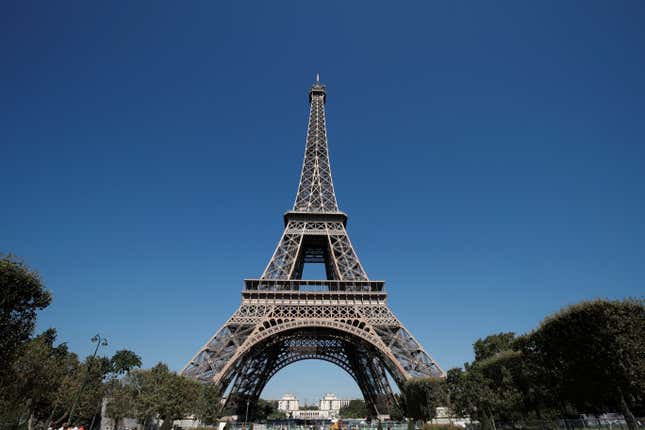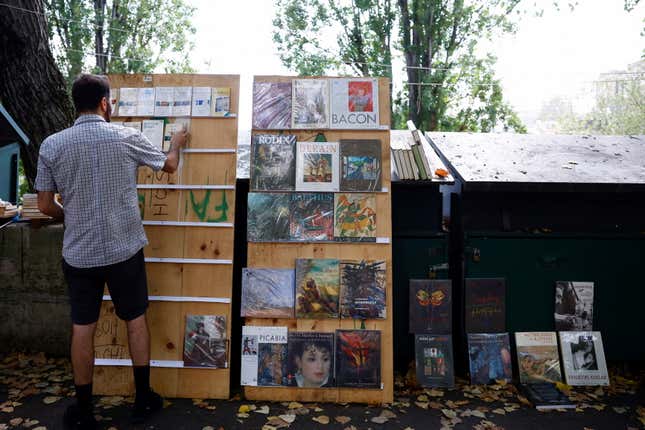
Disenchanted to meet you
Imagine walking through Paris for the first time, admiring the City of Lights, thinking of croissants, crème brûlée, and Gene Kelly tap-tapping on the streets, only to find that sidewalks of Montmartre are covered in dog shit.
It could almost make a visitor faint with disappointment. Some tourists nearly do. The phenomenon is known as Paris Syndrome, and it is almost exclusively experienced by Japanese travelers who find themselves in a state of extreme culture shock when encountering the grittier realities of the French capital.
Called Pari shōkōgun in Japanese, the illness is estimated to strike a couple dozen unsuspecting tourists a year. So why does this particular clash of cultures turn the City of Lights into the City of Frights?
Turns out idealizing any city is a dangerous path. Alors, join us on this tour to find out why.
By the digits
44 million: Number of tourists that visited Paris in 2022 according to the region’s tourism committee, making it the most visited city in the world for the second year in a row. Dubai came in second with 12 million visits.
$64.2 billion (€58 billion): Revenue France brought in from tourism in 2022
1.3 million: Number of Japanese tourists visiting France in 2023, according to data analytics firm GlobalData
20: Number of cases of Paris Syndrome occurring annually among Japanese tourists, according to Miyupi Kusama, a staffer at the Japanese embassy in Paris, as cited in a 2006 Guardian article
1: Ranking of Paris as the unfriendliest city in the world, according to a survey conducted by Rough Guides, a British travel guide publisher
Culture clash
Signs of the syndrome
Paris Syndrome is not formally recognized in the DSM-5 (Diagnostic and Statistical Manual of Mental Disorders, Fifth Edition), but has been recognized by medical professionals as a real disorder. Symptoms include dizziness, anxiety, vomiting, hallucinations, delusional states, and even tachycardia, or increased heart rate.
The term was first coined by Hiroaki Ota, a Japanese psychiatrist who worked at Sainte-Anne Hospital in Paris, in the 1980s. He and several co-authors published an article (link in French) on the subject in psychology journal Nervure in 2004.
It describes Paris Syndrome as a state of complete culture shock. Tourists from Japan, they theorized, are especially susceptible to having a disappointing experience in Paris because of how the city has been idealized in Japanese pop culture and media.
The language barrier, as well as differences in cultural norms and expectations are also identified as precipitating factors behind the disorder. “The stereotypical image of Paris, a city of consumption of luxury goods, widely conveyed by media sources, does not resist everyday life,” Ota et al. explain in the paper.
Quotable
“Meaning comes from the use of shared symbols and depression is a loss of meaning. This depression is the essence of culture shock. Culture shock is the anxiety and emotional disturbance experienced by people when two sets of realities and conceptualisations meet.”
—Rachel Irwin writing in her study, “Culture shock: negotiating feelings in the field” in Anthropology Matters Journal
Furansu, je t’aime
Japan’s love affair with France
Japan has long had a fascination with France. In the public imagination it is often regarded as a pinnacle of art, culture, fine dining, beauty, and good taste. Just look to Japan’s capital, where you can find Tokyo Tower, an imitation of the Eiffel Tower, and Odaiba’s Statue of Liberty, an ode to the French-built monument.
Tokyo even has a devoted French quarter, Kagurazaka, which is clustered with Parisian-influenced shops, cafes, and bakeries. If you pop into one of the area’s bookstores, you might be able to pick up some Proust or Voltaire translated into Japanese, or maybe a copy of The French have only 10 clothes, a popular book series in Japan (link in Japanese) on élégance et chic à la française.
“The Japanese see Paris as the City of Light, the most beautiful city in the world, the capital of refinement and romance. A mix of Chanel N°5 commercials, Amélie Poulain and black and white photos of Robert Doisneau,” said Eriko Nakamura, a Japanese journalist living in Paris, and author of the book (link in French) Naaande!? Les tribulations d’une Japonaise à Paris (Whhhy!? The tribulations of a Japanese woman in Paris).
Folie à deux
Other travel syndromes
Paris isn’t the only city to induce negative psychological effects. Similar, albeit rare, disorders have also been observed in two other famous cities.
Jerusalem has been found to cause some to fall into a psychotic state, especially those who are religiously inclined. An individual suffering from so-called Jerusalem Syndrome believes, upon visiting the ancient and holy city, that they are a Biblical figure (it even happened to Homer Simpson).
Stendhal syndrome is a mental condition that was first documented in the city of Florence, Italy. It refers to feelings of faintness, heart palpitations, or even hallucinations one might experience upon seeing great works of art and architecture. The phenomenon was named after Marie-Henri Beyle, known by his nom de plume Stendhal, who recorded his psychosomatic reaction to the Tuscan capital’s artistic treasures in 1817.
He wrote in his book Rome, Naples, and Florence (1818): “I was in a sort of ecstasy, from the idea of being in Florence, close to the great men whose tombs I had seen. Absorbed in the contemplation of sublime beauty... I had palpitations of the heart, what in Berlin they call ‘nerves.’ Life was drained from me. I walked with the fear of falling.”
Pop quiz

Which is NOT a real quote about Paris written by a novelist?
A. “To err is human. To loaf is Parisian.”
B. “I like Paris, but I’m not really sure Paris likes me.”
C. “There should be a name for the syndrome that occurs when you’re in Paris and you already miss it.”
D. “Paris, I believe, is a man in his twenties in love with an older woman.”
Wind your way through the charms of this email and you’ll stumble across the answer at the bottom.
Fun fact!
The French croquette was introduced to Japan in the late 1800s, and adapted to local palates. The resulting dish, called korokke, is in its most basic form a mashed potato patty covered in panko breadcrumbs and then deep fried. Korokke is a popular yōshoku dish, a style of cooking that arose in Japan during the Meiji Restoration (1868 – 1889) that was influenced by Western cuisine.
Watch this!
Japanese media, with a French twist
The Rose of Versailles, a classic and influential shōjo manga (a genre of comics targeting a younger female audience), was first published from 1972 to 1973 is another example of French influence on Japanese culture. The story takes place in Versailles prior to and during the French Revolution, and features Marie Antoinette as a main character. Have a listen to the anime’s opening theme song, “Bara wa utsukushiku chiru” (Roses Scatter in Beauty).
Take me down this 🐰 hole!
French avant-garde movements that emerged in the mid-20th century were very much interested in the impact of geography on psychology, creating a field of study known as “psychogeography.” The term was first defined by Guy Debord, a French marxist and philosopher, in his 1955 essay “Introduction to a Critique of Urban Geography.”
“Psychogeography could set for itself the study of the precise laws and specific effects of the geographical environment, consciously organized or not, on the emotions and behavior of individuals,” Debord wrote. He then mused: “Is it illogical or devoid of interest to observe that the district in Paris between Place de la Contrescarpe and Rue de l’Arbalète conduces rather to atheism, to oblivion and to the disorientation of habitual reflexes?” (We’re not sure what exactly that means, and might need to take a trip to find out.)
Debord also developed the concept of dérive (“drifting”) or the idea of wandering through urban spaces and immersing oneself in the surroundings without the usual motivations for movement (e.g. work, travel, shopping)—a concept somewhat similar to that of Charles Baudelaire’s sauntering and dandyish flâneur.
Poll
To those who have visited Paris, how was your experience?
- Loved it! It is truly one of the greatest cities in the world
- It was OK—some charms, but definitely overhyped
- I definitely felt some fainting spells coming on
- I have yet to risk Paris Syndrome by making a trip
Take a trip to our poll: no lines, no waiting, and never overbooked.
💬Let’s talk!
🤔 What did you think of today’s email?
💡 What should we obsess over next?
🩴 In last week’s poll about flip-flops, a whopping 66% of you wear your rubber footwear without socks, as nature intended. It was a relief to hear that only 2% of you wear them with specially made socks.
Also, many of you wrote in to tell us the words for “flip-flops” where you live, which was a great day in our inbox:
- Joshi says it’s “chappals” in India
- Tak says no self-respecting Hawaiian local would say “flip-flops” in favor of “slippa”
- Mike says Russians have three words, transliterated to “shlyopantsy,” “vietnamky,” and “slantsy” (after a town where a flip-flop manufacturer set up shop and printed its name on the soles)
- Catherine points out it is only “thongs” in Australia
Today’s email was written by Julia Malleck (orders two baguettes at a time, not one, because she can’t remember masculine/feminine articles), and edited by Annaliese Griffin (used her high school French to buy a truly ridiculous amount of cheese in Paris, impressing a Parisian fromager).
The correct answer to the quiz is B. “I like Paris, but I’m not really sure Paris likes me,” which is a line spoken by the character Emily in the oft-reviled, love-to-hate-watch show Emily in Paris. Option A. is a quote from Victor Hugo, C. is Rosecrans Baldwin, and D. is John Berger.